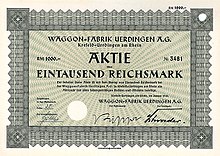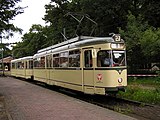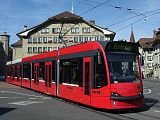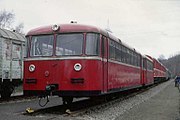Uerdingen wagon factory
The Waggonfabrik Uerdingen and the Düsseldorfer Waggonfabrik , operating together under the name DUEWAG between 1981 and 1999 , were one of the leading manufacturers of rail vehicles in Germany . The factory of Waggon-Fabrik AG Uerdingen , founded in Uerdingen in 1898, is now a manufacturer of regional and high-speed trains as part of Siemens Mobility .
history
founding
The founding deed of Waggon-Fabrik AG Uerdingen was signed on March 16, 1898 on the premises of the Essen Credit Institution . The signatories were Julius Dorsemagen (pensioner in Wesel), Hubert Hagedorn (trades in Essen), Franz Schwengers (entrepreneur in the Schwengers & Sons company in Uerdingen), Julius Weiler (entrepreneur in the Dr. E. ter Meer & Cie. Tar paint factory in Uerdingen, a predecessor of what would later become Bayer AG ), Friedrich Mauritz (businessman in Uerdingen), Hans Scheurer (engineer in Cologne) and Paul Craß (businessman in Malstatt-Burbach ), with the initiative to found the Uerdingen casino company. They elected the first supervisory board with Hubert Hagedorn as chairman and Franz Schwengers as deputy.
Schwengers & Söhne's rooms were used as offices until the first administration building was completed in 1900. The construction of factories and residential buildings for future staff members began immediately.
The company was founded at the time of the economic boom at the end of the century, but this also resulted in rising prices for building materials, machines and systems. The estimated costs for the construction were clearly exceeded even before the start of production, which resulted in financial problems. An economic slowdown after completion of the plant was also noticeable, as other already established wagon factories were still benefiting from the previous boom.
The first years
As early as January 24, 1899, the company received its first test order from the Prussian State Railways for 186 wagons of various types, which after production started in April 1899, all of which left the factory after just twelve months of production. This was followed by a first private order from the Hoya-Syke-Asendorf small railway . Private orders were an important pillar, as the trust of the state railroad still had to be earned with their livelihood contracts. The geographic location of Uerdingen near the Ruhr area , near the Dutch border and not far from the North Sea offered advantages . Orders from heavy industry followed, as well as the first vehicles for the trams in the Ruhr area. Exports went to the Netherlands, Luxembourg, Italy, India and London.
In June 1904, a major fire in the woodworking workshops threatened the existence of the wagon factory. Wood was a key building material for wagons at the time, and so no deliveries could take place at first. The incoming money stopped. The reconstruction was able to start, among other things, with the help of victims of the shareholders. A corresponding dividend policy made it possible to use the profits for construction, development and research. Later, around 800 wagons a year left the plant until around 1914. The Waggonfabrik Uerdingen joined the newly founded Association of German Waggonfabriken based in Berlin . Nevertheless, the period of the First World War forced the postponement of all development work in order to focus exclusively on the work that was necessary for the war.
From 1918, the architect Wilhelm Mohr was commissioned to design the interior fittings for the company's tram cars. In 1920 the Uerdingen wagon factory had its own fire brigade . In 1921 around 1,300 people were employed here , handling the first orders for the Vestische trams and for the Rheinische Bahngesellschaft AG , later the Rheinbahn , after which the Uerdingen plant was expanded. Among other things, tank cars became the focus of production.
In the early 1920s, up to 3,000 cars were produced per year, including mostly freight cars and the first D-Zug unit cars of third class (C4ü) with riveted steel car bodies . The founder of the company Dr. E. ter Meer & Cie , Edmund ter Meer , was chairman of the supervisory board in 1921.
In 1921 the Waggonfabrik Uerdingen became a member of the Eisenbahnwagen-Liefergemeinschaft GmbH (EISLIEG) in Düsseldorf, together with the wagon construction company Waggonfabrik H. Fuchs AG in Heidelberg, Düsseldorfer Eisenbahnbedarf, vorm. Carl Weyer & Co. , Siegener Eisenbahnbedarf AG, Dessauer Waggonfabrik AG and Wegmann & Co. in Kassel. With an annual production capacity of 18,000 to 20,000 vehicles, this delivery group represented the strongest and most efficient group within the German wagon construction industry. In 1926, it dissolved again when the Deutsche Reichsbahn-Gesellschaft (DRG) had its own plan for the award of its orders Suppliers developed.
The railway business was interrupted in 1923 due to the occupation of the Ruhr , as the complete cut-off of rail traffic made it impossible to deliver materials and products. At the end of November 1923, the main customer, the Deutsche Reichsbahn , stopped all payments for several months, which led to the plant being closed until the end of February 1924 and the dismissal of the workforce. Due to a general strike, no emergency work could be carried out either. The Deutsche Reichsbahn also stopped its regular awarding of contracts. You could survive the time with other orders for special vehicles, trams and bus bodies. In 1926, orders from the Deutsche Reichsbahn followed again, because in the same year the Deutsche Reichsbahn and 30 wagon construction companies, including Uerdingen, signed the Reichsbahn contract for the award of state railroad contracts. In this, the Deutsche Reichsbahn committed itself to awarding around 90 percent of its wagon construction contracts to the companies that had come together in this Deutsche Wagenbau-Vereinigung . The Eisenbahnwagen Liefergemeinschaft GmbH (EISLIEG) was thus dissolved.
In 1925, some of the employees lived in 63 factory buildings. In that year, the first steel bodies for buses were sold . In 1928 the subsidiary Press- und Ziehwerk GmbH was founded. A special laboratory was set up in the Uerdingen plant to carry out technological and economic studies.
Ringfeder GmbH
On December 4, 1922, Ringfeder GmbH was founded for the purpose of selling ring springs and friction buffers . Ernst Kreißig was its technical director until 1954.
The annular spring GmbH developed and produced spring Apparatus for buffer by the now used Kunze-Knorr-Bremse were required. These springs are stacked alternately in two sizes as a horizontally lying stack, so that when the wagons drive on, the large spring washers are stretched and the smaller ones are compressed. When they slide into one another, they also dampen due to their friction, which results in less wear and tear. Later these springs became compulsory for express train wagons of the Deutsche Reichsbahn, among other things, they replaced the rod buffers with clock springs that were used until then. Annular springs were produced under license in Japan, the USA, Italy and France . The company also produces mouth couplings , an automatically self-closing trailer coupling that is considered the standard for commercial vehicles worldwide.
In 1939 a special factory was built in Wurzen to manufacture ring springs, which was lost in the Second World War . In 1997, after Siemens took over the company, Ringfeder GmbH in Uerdingen was sold. Today it is part of the VBG Group Truck GmbH in Krefeld.
1930s
Since 1935, the focus in Uerdingen was on the construction of railway vehicles , while vehicles for local transport , especially trams , were manufactured in the Düsseldorf wagon factory , which was built in 1916 . Under the title Lightweight Construction, a Hidden Source of Raw Materials , the Waggonfabrik presented a special show at the Reichsausstellung Schaffendes Volk in Düsseldorf in 1937 . On January 25, 1938 which was car-Fabrik AG, Uerdingen the wagon factory Uerdingen AG . In 1939 the Deutsche Reichsbahn demanded the basic use of the Uerdingen lightweight wheelset, which was largely developed in Uerdingen and manufactured by the Bochumer Verein .
Second World War and the aftermath
The Uerdingen plant was badly damaged in the Second World War . In particular, the woodworking workshops to the west of the sliding platform road in the center of the plant were destroyed by incendiary and high explosive bombs. Over 10,000 cubic meters of high-quality precious woods, at that time the company's most valuable item, were confiscated by the Allies and transported away in 1945 . The branch of Ringfeder in Wurzen, which was now occupied by the Soviets, was lost. After the war, work was initially resumed with the repair of freight wagons . 300 tram sidecars were also able to be delivered from existing stocks. Later, in 1949, all-steel construction for wagons was introduced.
For the 50th anniversary of the company, the day of remembrance, Tuesday, March 16, 1948, was celebrated in silence and a memorial was published. In the times of the just past Second World War and the collapse, there was no need for a celebratory anniversary.
DUEWAG AG
The Gebr. Schöndorff stock company was a German company based in Dusseldorf , which was active from 1890 in the field of wood processing, first in the construction of furniture and shop fittings, and later of carriages and trams. From 1915, the Hindenburg program saw the establishment of a modern, high-performance wagon production facility aimed at building modern tram cars. In 1935 Waggon-Fabrik AG, Uerdingen, took over the entire share capital of Düsseldorfer Waggonfabrik AG from Linke-Hofmann-Busch-Werke AG , with the Talbot wagon factory in Aachen receiving 25 percent shares. But the exemplary, then youngest wagon factory was run down, so that the Uerdingen wagon factory took on debts amounting to millions. A few years later, the Düsseldorf plant was able to work profitably again.
In 1959, the Düsseldorfer Waggonfabrik AG was fully integrated into the Uerdingen company. In 1981 the company with its plants in Uerdingen and Düsseldorf was officially named DUEWAG AG, with the majority of the shares held by the Talbot wagon factory . Duewag Inc., Canada , based in Calgary, was founded in August 1984 and dissolved in November 1995.
With the BKK DUEWAG, DUEWAG AG had its own company health insurance fund , which was merged with the Siemens company health insurance fund on January 1, 1999 .
Takeover by Siemens AG
In 1989, the Siemens group took over the majority of shares in Duewag and bought the shares in the Talbot wagon factory. DUEWAG AG sold its entire operating business in 1999 and thus became a wholly-owned subsidiary of Siemens AG under the name Siemens Duewag Rail Vehicles GmbH . On September 1, 1996, Siemens Rail Vehicle Technology GmbH on Helenenstrasse in Essen , formerly Krupp Verkehrstechnik GmbH , was incorporated into Siemens Duewag Rail Vehicles GmbH in Uerdingen. Now the Uerdingen plant has become a manufacturer of ICE high-speed trains and, for a short time, of class 152 electric locomotives . A year later, Ringfeder GmbH , located on the factory premises, was sold and also spatially outsourced.
In 2000, the Düsseldorf location was closed and its production was integrated into the Uerdingen plant, so that tram vehicles ( Combino ) were also built in Uerdingen . Since September 1, 2002, the Uerdingen plant has been completely merged with Siemens AG . The free shareholders were compensated by way of a squeeze-out . Today's entrance and administration building, including the staff casino, was built in 2003 with a gross floor area of around 6000 m² by the architectural office Herbert F. Zabel, Düsseldorf. The last tram produced in Uerdingen left the plant in 2012.
Waggon factory today
Today, the wagon factory with a production area of around 74,000 m² is the production site for regional and long-distance trains for worldwide customers in Siemens Mobility GmbH . The most important products include the Desiro series and the Velaro high-speed trains .
Product selection since the factory was founded
The products of the Uerdinger Waggonfabrik range from various freight cars , especially tank cars , to omnibuses , trolleybuses and tram cars, to passenger carriages and complete diesel and electric multiple units , even today in the high-speed range.
Tram, light rail and subway vehicles
In the tram sector, Duewag had a dominant market position for a long time. The majority of the tram vehicles procured in the Federal Republic of Germany after the Second World War came from Duewag or were manufactured under license . The two most important representatives were the Duewag open-plan car (from 1951) and the Duewag articulated car (from 1956). In the work the Dusseldorf Duewag 1965 produced for the Frankfurt U-Bahn for the first time two six-axle rail - prototype vehicles that largely railcar tram based on the previously delivered. It was first presented in 1965 at the International Transport Exhibition in Munich . The Simatic electronic control from Siemens and the possibility of coupling several railcars to form train sets were new . However, there was no series production. They were mainly used for driving school and test drives and only ran in regular service for a few years. They were shut down in 1976 because they were incompatible with the U2 light rail cars . The experience gained with the prototypes flowed into the successor U2 , which was delivered in a total of 104 copies to Frankfurt and was in use there until 2016. North American operations in Edmonton , Calgary and San Diego also purchased the U2 railcar in the period that followed.
Later, Duewag manufactured numerous types of light rail vehicles for almost all West German light rail companies. These include the light rail car type Mannheim , stadtbahnwagen b , light rail vehicles Type M / N , the types P , U3 and U4 for Frankfurt and the rail car type Hannover and the GT8-100C / 2S for Karlsruhe .
In the mid-1950s, the DT1 subway double multiple unit was developed for the Hamburger Hochbahn (HHA) and built in Uerdingen in 1958/1959.
With the Combinos , and after the Düsseldorf plant was closed in 2000, tram vehicles were also manufactured in the Uerdingen plant until 2011.
Open seating car train of the Frankfurt am Main tram
Railway products
Over the years, the Uerdingen wagon factory has manufactured various freight cars , tank cars , passenger coaches and complete combustion and electric multiple units .
The freight wagons included the types UIC-571 , Omm 52, four-axle flat wagons of the type SSlmas 53 and so-called stake wagons .
In addition, several tank cars, were Silowagen the type UCS 54, UCS 56 and UCS 67, Selbstentladewagen and Kübelwagen the genus Okmm 58th
The types AB 4ymg-51 of the 1st and 2nd carriage classes are to be mentioned for passenger coaches . Type 4mg-a / 26 and 4mg-b / 26 rail mail cars were also part of the product range.
The railcars include the DB series VT 24.5 , ET 30 , as well as the DB series 628 , 420 , 423 , 425 , some of which have recently been produced in consortia with other manufacturers . For this coming high-speed series of ICE 2 , ICE 3 and ICE T . Today, the Desiro , Mireo and Velaro production platforms fall under Siemens production .
Uerdinger rail bus of the VT 95.9 series
Dutch DM90 diesel multiple unit
ICE 3: DB class 407
Uerdinger rail bus
From 1950 to 1971 the Uerdingen rail bus was produced with a total of almost 1,500 pieces in different versions and licenses. The two types of trolleybuses ÜHIIs and ÜHIIIs are closely related to this .
literature
- Waggonfabrik Uerdingen AG (Ed.): Commemorative publication for the 50th anniversary of Waggonfabrik Uerdingen AG, Uerdingen . Uerdingen 1948.
- Stefan Karch: From the history of the Uerdingen wagon factory: Duewag Aktiengesellschaft. The company and its developments . Moers 1986, p. 381-389 .
- Uerdinger Heimatbund eV (Ed.): Uerdinger yearbook 2008: From the history of the Uerdingen wagon factory . Stefan Kronsbein, Uerdingen 2008, ISBN 978-3-935526-16-6 , pp. 83-92 .
- K. Meschede, A. Reuther, J. Schöber: The classic DÜWAG articulated wagon · A tram success story from the Düsseldorf wagon factory . EK-Verlag, Freiburg 2013, ISBN 978-3-88255-853-1 .
Web links
- Early documents and newspaper articles on the Uerdingen wagon factory in the 20th century press kit of the ZBW - Leibniz Information Center for Economics .
- Documents and newspaper articles on the Düsseldorfer Waggonfabrik in the press kit 20th Century of the ZBW - Leibniz Information Center for Economics .
Individual evidence
- ↑ From the Werkbund to the four-year plan. The Great Imperial Exhibition “Creative People”. Düsseldorf 1937 - Directory of persons ( Memento of the original from October 21, 2013 in the Internet Archive ) Info: The archive link was inserted automatically and has not yet been checked. Please check the original and archive link according to the instructions and then remove this notice. , accessed February 23, 2014.
- ↑ 20. Annual report of Waggon-Fabrik AG Uerdingen for the business year 1919/1920
- ^ The German railway system of the present. Reimar Hobbing, Berlin 1923, p. 480 ff.
- ↑ a b 25th annual report of Waggon-Fabrik AG Uerdingen for the business year 1923/1924
- ↑ 27. Annual report of Waggon-Fabrik AG Uerdingen for the business year 1924/1925
- ↑ The Ringfeder today
- ↑ Transfer procedure for minority shareholders
- ^ Siemens Mobility. Siemens AG, accessed on February 24, 2015 .
- ↑ Bernd Conrads: Frankfurt veteran: The "U2" car is retiring. In: VGF blog. Retrieved December 24, 2017 .
Coordinates: 51 ° 22 ′ 5 " N , 6 ° 38 ′ 45" E



















